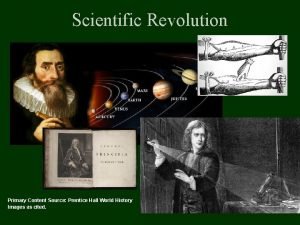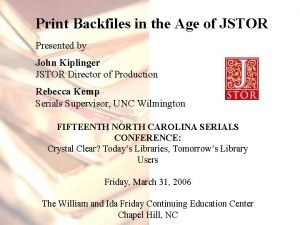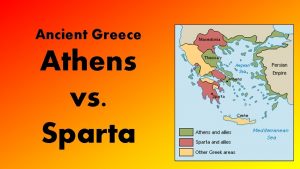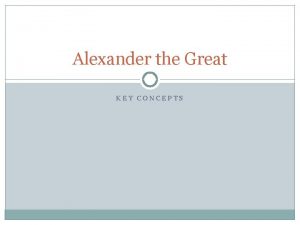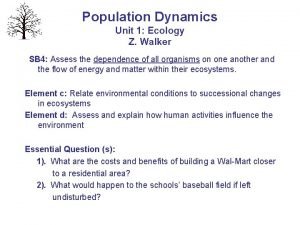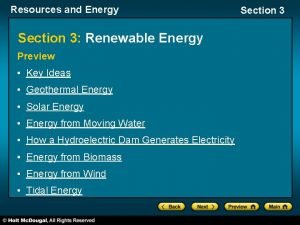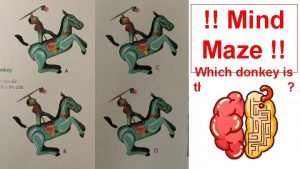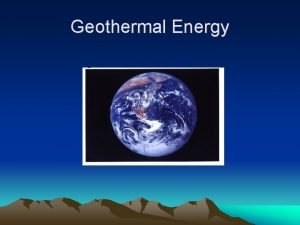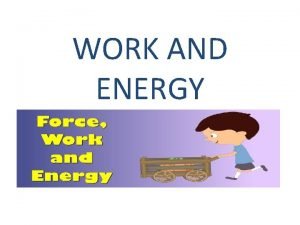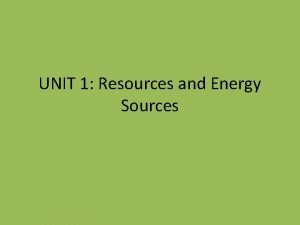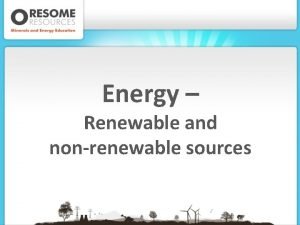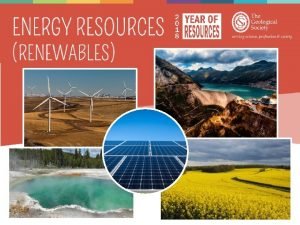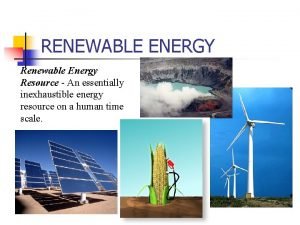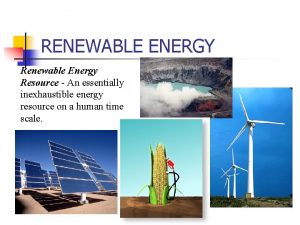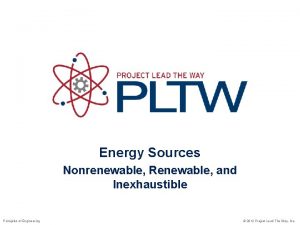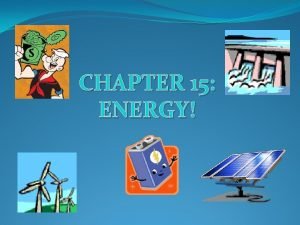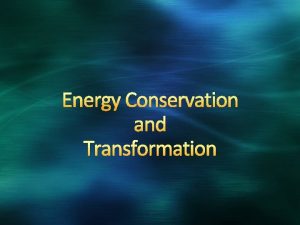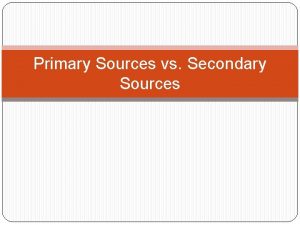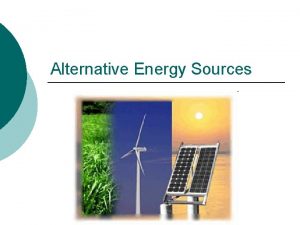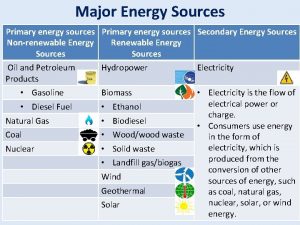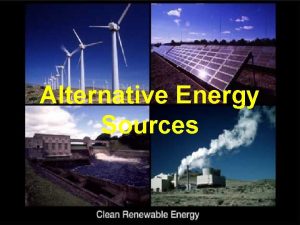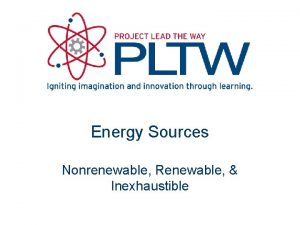Sources of Energy Primary energy sources A primary
























































- Slides: 56

Sources of Energy Primary energy sources A primary energy source is an energy source, such as coal, wind, oil, gas, or water, which is used directly by the consumer.

Primary energy sources You should have a good idea of these percentages, from memory. Fossil CO 2 fuels

Secondary energy sources A secondary energy source is an energy source, such as electricity or hydrogen, which has been transformed from a primary energy source before use by the consumer.

Renewable and non-renewable energy sources Renewable resources can be replaced in a reasonable amount of time (or are not depleted).

Energy density – the energy that can be obtained from a unit mass of the fuel – measured in J kg-1 Fuel Cow dung Wood Coal Oil Diesel Petrol Uranium Fusion fuel Energy density (MJ/kg) 15. 5 17. 0 32. 5 41. 9 45. 8 46. 9 90, 000 300, 000

How much wood is needed to power a 6000 horsepower steam engine locomotive for five hours? 1 hp = 0. 75 k. W and a steam engine is about 12% efficient (Wood 17. 0 MJ/kg) a)How much energy does the engine use in 5 hours? b)To get this much energy out, how much energy needs to be put in given the engine’s efficiency? c)What mass of wood is required for this much energy? The energy density of coal is twice as much as wood and coal is twice as dense so the volume of coal required to do the same amount of work as wood is a quarter as much.

When a car is driving at 80 km/hr, it is doing work against air resistance at a rate of 40 k. W. a)How far will the car travel in 1 hour? b)How much work does the car do against air resistance in 1 hour? c)If the engine of a modern diesel car is 75% efficient, how much energy is the fuel producing? d)If the energy density of diesel is 45. 8 MJ/kg, how many kg of diesel will the car use? e)If the density of diesel fuel is 0. 9 kg/liter, how many liters will the car use? f) Calculate the liters of fuel used per kilometer.

Energy degradation and power generation Energy degradationenergy is always conserved but cannot all be used to perform mechanical work Unavailable energy is called degraded energy

Energy transfer (change) A lamp turns electrical energy into heat and light energy

Sankey Diagram A Sankey diagram is used to show the energy conversions that occur in a device.

Sankey Diagram The thickness of each arrow is drawn to scale to show the amount of energy

Sankey Diagram Notice that the total amount of energy before is equal to the total amount of energy after (conservation of energy)

Efficiency Although the total energy out is the same, not all of it is useful.

Efficiency is defined as Efficiency (%) = useful energy output x 100 total energy input

Example Efficiency = 75 x 100 = 15% 500

Energy efficient light bulb Efficiency = 75 x 100 = 75% 100 That’s much better!

Examples of Sankey diagrams

Energy diagram for the US. Energy flows from left to right.

Describing fossil fuel power stations The most common way to generate electrical power is the coal-burning power plant. Chemical energy in coal is released by burning. Heat boils water. Steam rotates a turbine. The turbine turns Turbine a coil of wire in a Generator magnetic field. Electrical power is produced. Coal Condenser Boiler

Fossil Fuels Advantages Relatively cheap (while they last) High energy density Variety of engines and devices use them easily Extensive distribution network in place Disadvantages Will run out Pollute the environment Contribute to greenhouse effect by releasing greenhouse gases

Nuclear energy Advantages High power output Large reserves of nuclear fuel No greenhouse gases are produced Disadvantages Radioactive waste is difficult to dispose of Major public health hazard if something goes wrong Problems associated with uranium mining Possibility of producing materials for nuclear weapons

Describing nuclear power stations Nuclear power stations are the same as fossil fuel stations, from the turbine on down. Heat Kinetic Electrical

Describing nuclear power stations Nuclear fission is the splitting of a large nucleus into two smaller (daughter) nuclei. An example of fission is 235 U + 1 n 236 U*) 140 Xe + 94 Sr + 2(1 n) ( 92 0 92 54 38 0 In the animation, 235 U is hit by a neutron, and capturing it, becomes excited and unstable: It quickly splits into two smaller daughter nuclei, and two neutrons, each of which can split another nucleus of 235 U. 94 Sr 140 Xe

Describing nuclear power stations Note that the splitting was triggered by a single neutron that had just the right energy to excite the nucleus. 235 U + 1 n 236 U*) 140 Xe + 94 Sr + 2(1 n) ( 92 0 92 54 38 0 Note also that during the split, two more neutrons were released. If each of these neutrons splits subsequent nuclei, we have what is called a chain reaction. 1 2 8 Primary 4 Secondary Tertiary Exponential Growth

Describing nuclear power stations We call the minimum mass of a fissionable material which will sustain the fission process by itself the critical mass. Note that 238 U is not even in this list. This is why we must enrich naturally-occurring uranium for reactor usage.

Describing nuclear power stations In a nuclear reactor, a controlled nuclear reaction is desired so that we merely sustain the reaction without growing it. In a nuclear bomb, an uncontrolled nuclear reaction is desired so that we have an immense and very rapid energy release. Half of the product neutrons are absorbed by the control rods controlled Few of the product neutrons are absorbed uncontrolled

Describing nuclear power stations Recall that a typical fission of 235 U will produce two (and sometimes 3) product neutrons. These neutrons have a wide range of kinetic energies EK. If the EK value of a neutron is too high, it can pass through a 235 U nucleus without causing it to split. If the EK value is too small, it will just bounce off of the 235 U nucleus without exciting it at all. too slow too fast

1 -2 Me. V average fuel rod 5 0 10 Neutron energy / Me. V moderator Describing nuclear power stations Most of the neutrons produced in a reactor are fast neutrons, unable to split the 235 U nucleus. These fast neutrons will eventually be captured by 238 U, or they will leave the surface of the fuel rod, without sustaining the fission reaction. Moderators such as graphite, light water and heavy water slow down these fast neutrons to about 0. 02 e. V so that they can contribute to the fission process.

moderator Describing nuclear power stations In order to shut down, start up, and change the reaction rate in a reactor, neutron-absorbing control rods are used. Retracting the control rods will increase the reaction rate. Inserting the control rods will decrease the reaction rate. Control rods are made of cadmium or boron steel.

moderator Describing nuclear power stations The whole purpose of the reactor core is to produce heat through fission. The fuel rods, moderator and control rods are all surrounded by water, or some othermal absorber that can be circulated. Some reactors use liquid sodium! The extremely hot water from the reactor core is sent to the heat exchanger which acts like the boiler in a fossil fuel power plant.

Describing nuclear power stations The heat exchanger extracts heat from the circulating reactor coolant and makes steam to run the turbine. control rods turbine generator heat exchanger cooling tower condenser

Wind power Movement of air causes a fan (turbine) to spin Power developed = P = ½ Av 3 Power depends on the wind speed, the density of the air and the area of the blades.


A turbine with a turbine blade length of 54 m is operated in a wind of speed 10 m/s. The density of the air is 1. 2 kg/m 3. a) How much power is in the wind passing through the turbine? b) How much electrical power can be generated if the turbine is 20% efficient? c) If the wind speed increased to 15 m/s, how much power would be produced?

PRACTICE: Since the air is still moving after passing through the rotor area, obviously not all of the kinetic energy can be used. The maximum theoretical efficiency of a wind turbine is about 60%. Given a turbine having a blade length of 12 m, a wind speed of 15 ms-1 and an efficiency of 45%, find the power output. The density of air is = 1. 2 kg m-3. SOLUTION: A = r 2 = (122) = 452 m 2. Power = (0. 45)(1/2)A v 3 = (0. 45)(1/2) 452 1. 2 153 = 411885 W = 410 k. W.

Wind power doesn’t produce greenhouse gas. Wind power is a renewable resource. Wind depends on the weather. 2 GW / 0. 8 MW = 2500 turbines required!

Describing hydroelectric systems We can divide hydroelectric power production into two groups: Sun-derived uses sun-driven potential energy. Moon-derived uses tidal-driven potential energy. Hoover Dam: 1. 5 109 W Rance Tidal Barrage: 2. 4 108 W

Describing hydroelectric systems – sun-driven A typical hydroelectric dam: Sun-driven evaporation and rainfall place water at a high potential energy. During times of less energy demand, excess power plant electricity can be used to pump water back up into the reservoir for later use. This is called the pumped storage scheme.

Ocean side Estuary side

PRACTICE: A reservoir for a hydroelectric dam is shown. The density of water is 1000 kg m-3 (a) Calculate the potential energy yield. SOLUTION: The total volume of water is V = 1700(2500)(50) = 2. 125 108 m 3. The mass of the water is m = V = (1000 kg m-3)(2. 125 108 m 3) = 2. 125 1011 kg. The average water height is h = 75 + 50 / 2 = 100 m. The potential energy yield will then be EP = mgh = (2. 125 1011)(100) = 2. 125 1014 J.

PRACTICE: A reservoir for a hydroelectric dam is shown. (b) If the water flow rate is 25 m 3 per second, what is the power provided by the moving water? P = W/t = mgh/t = = Since power is measured in W (or J s-1) the power provided is 2. 5 107 W = 25 MW.


Active solar devices (solar panels)– sunlight is used to heat water or air in a house, pipes with circulating water are exposed to sunlight and collect heat energy Photovoltaic cells – convert sunlight using semiconductors into DC current

Solar energy Advantages “Free” Inexhaustible Clean Disadvantages Vary dependent on location Requires drastic changes to environment Initial costs high Low energy density

The sun’s intensity can be found by dividing the power of the sun by the area it is striking. Data booklet

Why is the power delivered by the sun different for different parts of the earth? 1380 W/m 2

The intensity also varies with the season, which is due to the tilt of Earth.

EXAMPLE: A photovoltaic cell has an area of 1. 00 cm 2 and an efficiency of 10. 5%. (a) If the cell is placed in a position where the sun's intensity is I = 1250 W m-2, what is the power output of the cell? SOLUTION: A = (1 cm 2)(1 m / 100 cm)2 = 0. 0001 m 2. PIN / A = I so PIN = IA = 1250(0. 0001) = 0. 125 W. The cell is only 10. 5% efficient so that POUT = 0. 105 PIN= 0. 105(. 125) = 0. 0131 W.

EXAMPLE: A photovoltaic cell has an area of 1. 00 cm 2 and an efficiency of 10. 5%. (b) If the cell is rated at 0. 500 V, what is its current output? P = IV so that I = P/ V = 0. 0131/. 5 = 0. 0262 A.

EXAMPLE: A photovoltaic cell has an area of 1. 00 cm 2 and an efficiency of 10. 5%. (c) How many cells would you need to operate a 100 W circuit? SOLUTION: (c) Pout = 0. 0131 W/ cell. Thus (100 W) / (0. 0131 W/ cell) = 7630 cells!

Efficiency = Pout / Pin so that Pin = Pout / Efficiency = 47 10 -3 / 0. 08 = 0. 5875 W. Thus I = Pin / A = 0. 5875 W / 6. 5 10 -4 m 2 I = 900 W m-2 = 0. 90 k. W m-2.

Cloud cover variation is one reason. Season is another reason.

sunlight Describing solar energy systems – heating panels The heating panel converts sunlight directly into heat. The slower the water glass is circulated, the hotter it can get. on i t la u ins black water pipe cold absorber hot water out water in

The density of water is 1000 kg m-3

Because of the tilt of Earth’s axis southern exposures get more sun in the northern hemisphere, and northern exposures get more sun in the southern hemisphere.

From Topic 3 the energy needed for ∆T = 25 K is Q = mc∆T = 140(4200)(25) = 1. 47 107 J. But POUT = Q / t = 1. 47 107 J / (6 h)(3600 s / h) so that Pout = 681 W. Since Efficiency = POUT / PIN = 0. 35 then PIN = POUT / Eff. = 681/0. 35 = 1944 W. From I = PIN / A we get A = PIN / I so that A = 1944 / 840 = 2. 3 m 2.
 Print sources of information
Print sources of information Importance of water source
Importance of water source Primary energy and secondary energy
Primary energy and secondary energy Hypdro
Hypdro Lindisfarne raid primary sources
Lindisfarne raid primary sources Scientific revolution primary sources
Scientific revolution primary sources Uncw jstor
Uncw jstor Primary evidence vs secondary evidence
Primary evidence vs secondary evidence Buffalo soldiers primary sources
Buffalo soldiers primary sources Primary secondary and tertiary sources
Primary secondary and tertiary sources Primary sources
Primary sources What is a secondary source
What is a secondary source Is an autobiography a primary source
Is an autobiography a primary source What are primary and secondary sources of light
What are primary and secondary sources of light Mai lai massacre primary sources
Mai lai massacre primary sources Sparta primary sources
Sparta primary sources Alexander the great hephaestion
Alexander the great hephaestion Execution de saigon
Execution de saigon Ancient greek olympics primary sources
Ancient greek olympics primary sources The primary source of light is
The primary source of light is Secondary sources
Secondary sources Defining and debating america's founding ideals
Defining and debating america's founding ideals Boston massacre csi
Boston massacre csi Xerxes primary sources
Xerxes primary sources Slave trade primary sources
Slave trade primary sources Parchemnet
Parchemnet Myall creek massacre primary sources
Myall creek massacre primary sources Fort pillow massacre primary sources
Fort pillow massacre primary sources Ecological succession
Ecological succession Energy energy transfer and general energy analysis
Energy energy transfer and general energy analysis Energy energy transfer and general energy analysis
Energy energy transfer and general energy analysis Section 3 renewable energy sources worksheet answers
Section 3 renewable energy sources worksheet answers Renewable energy concepts
Renewable energy concepts Nonrenewable energy sources
Nonrenewable energy sources Energy
Energy Nonrenewable energy sources
Nonrenewable energy sources Sources of natural heat
Sources of natural heat The principal source of earth’s internal energy is
The principal source of earth’s internal energy is Sources of chemical energy
Sources of chemical energy Define resources
Define resources Non renweable resources
Non renweable resources Classification of energy sources
Classification of energy sources Use of alternative energy sources ppt
Use of alternative energy sources ppt Renewable energy sources are essentially inexhaustible
Renewable energy sources are essentially inexhaustible Is solar energy renewable or inexhaustible
Is solar energy renewable or inexhaustible Department of energy
Department of energy Nonrenewable energy sources quizlet
Nonrenewable energy sources quizlet Magenta cyan and yellow are the ____ color. *
Magenta cyan and yellow are the ____ color. * Primary energy demand
Primary energy demand Section 2 describing energy worksheet answers
Section 2 describing energy worksheet answers Potential energy in spring
Potential energy in spring Gibbs free energy equation
Gibbs free energy equation Gibbs free energy vs standard free energy
Gibbs free energy vs standard free energy Radiant energy to mechanical energy
Radiant energy to mechanical energy Thermal energy vs heat energy
Thermal energy vs heat energy A hairdryer converts ____ energy into ____ energy.
A hairdryer converts ____ energy into ____ energy. Potential energy to electrical energy
Potential energy to electrical energy





